Venomous Snakes of Georgia: There are 41 different species of snake found in the state of Georgia which is a pretty high figure when compared to some of the others. The good news is that although there are a lot of snakes present, only a small percentage of them are harmful to humans, considered venomous.
Call the below number for snake removal help in your area:
Athens-Clarke: 678-809-6635
Atlanta: 404-609-4280
Columbus: 706-780-5427
Lawrenceville: 404-609-4280
Macon: 478-488-3003
The venomous snakes of Georgia include:
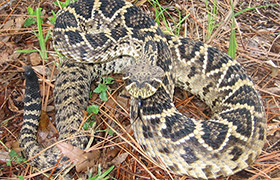
Eastern Diamondback Rattlesnake: Just like many other venomous snakes, many of the rattlesnakes that can be found in the state of Georgia will have a triangular and rather flat-shaped head followed by a thinner, more elongated neck. This is much the same for all the venomous rattlesnakes that can be found here, not that it really helps because a lot of the non-venomous snakes also have a habit of ‘flattening’ their head and jaw area in order to look bigger and more threatening to predators.
The eastern diamondback rattlesnake is the most dangerous of all venomous snakes of Georgia although if you leave it alone, it will generally leave you alone right back. This is a very large snake with no real natural predators, meaning it’s right at the top of its food chain. Generally, you’ll find this snake more toward the southern areas of the state of the Georgia.
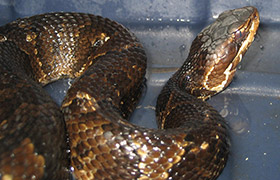
Cottonmouth (Water Moccasin): The water moccasin or cottonmouth snake is a dark-colored snake often confused with a number of other non-venomous snakes, particularly water snakes of the green and brown variety. You’ll more than likely find this one towards the central (middle) and southern areas of the state, in places where you’ll find more watery areas and marsh / swamplands.
A rather dangerous snake, the second on the list, there is enough venom in one bite to kill a human without medical treatment, and the snake can be very aggressive when threatened, something it will feel if you get a little closer thinking it’s a non-venomous and relatively snake to approach.
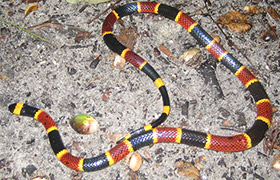
Eastern Coral Snake: Another snake you’ll commonly find the more south of Georgia you go, the coral snake (or eastern coral snake) has markings that many other non-dangerous snakes use to make themselves appear more threatening. The black, red and yellow markings immediately shout danger and to the untrained eye, it can be hard to tell between a dangerous one and a non-dangerous one, meaning you should probably leave anything with similar markings alone.
Third on the list, this is a very shy snake that doesn’t really go looking for trouble, and actually amounts to less than 1% of all snake bites in the entire USA. There is a reason for this run-and-hide attitude - their fangs need to be latched on for the venom to steadily seep through rather than injecting a straight burst of something toxic. This snake will only attack back if it absolutely needs to, perhaps making it as rare as it is to see and be bitten by one.
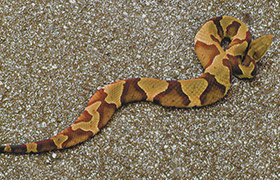
Southern Copperhead: Fourth on the list is the copperhead, or southern copperhead, a snake that you’ll spot almost everywhere across the state. This is not the most dangerous but is one of the most common venomous snakes of Georgia, although its venom would only be enough to fatally wound a small child or a small household pet. An adult bite is rarely more than mild irritation that occasionally requires medical treatment.
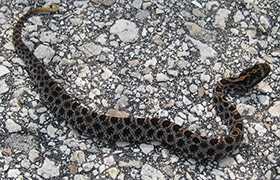
Pygmy Rattlesnake: The smallest and last on the list of venomous snakes of Georgia is the pygmy rattlesnake, another snake known by a host of different names - dusky pygmy, pigmy, ground rattlers or rattlesnakes, buzzworms, and more. The buzzword name is actually very appropriate - at less than 30 inches in length, the snake and it’s rattle are so small it actually sounds more like a loud insect buzz than the warning noise of a rattlesnake.
Feisty and highly venomous, the snake isn’t as dangerous as the other larger snakes on the list but can still post a threat to kids and small pets, and can even cause internal bleeding and severe bruising in adults that may require medical attention.
Another snake known by many other names, the timber rattler or rattlesnake, can be found everywhere across the state, just like the copperhead snake. You’ll more than likely spot this snake in rocky outcrops or perhaps in wooded and forested hillsides, and although deadly with a potent bite, is rarely grumpy enough to strike back, and will only feel the need to bite when cornered or threatened. For more information, go to my Snake Removal - How to Get Rid of Snakes home page, and learn more about how to get rid of the poisonous snakes of Georgia.